The editorial for REVITALIZATION was written by Storm Cunningham, RE.
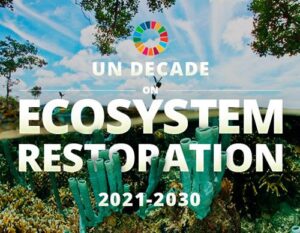 What I feared has come to pass.
What I feared has come to pass.
The United Nations has published its strategy for the UN Decade on Ecosystem Restoration, and it’s a failure on Day One. Harsh words, granted…especially because so many wonderful people put so much hard work into it. And it is, in fact, a wonderful document.
So why do I pronounce it a failure? Because it’s a plan, not a strategy. If they had called it a plan, I wouldn’t call it a failure. This isn’t just semantics: it’s the difference between a decade of actual ecosystem restoration success on one hand, and yet another ignored, shelved document on the other.
The word “strategy” is used 24 times in the course of this 48-page strategy document. So far, so good.
But only once is there any attempt to actually state the strategy. And even that seems to be mostly an accident of wording, rather than conscious intention, since it’s buried in the document.
Let’s back up a bit. On March 4, 2019, the United Nations recognized the critical role of ecosystem restoration as a tool for improving environmental conditions and enhancing human communities by designating 2021-2030 the UN Decade on Ecosystem Restoration, as documented here in the March 15, 2019 issue of REVITALIZATION.
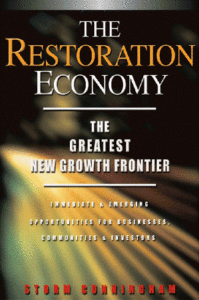 It was initially suggested to them by the UNEP delegation from Costa Rica. (My first book, The Restoration Economy, proposed a “century of restoration” back in 2002.)
It was initially suggested to them by the UNEP delegation from Costa Rica. (My first book, The Restoration Economy, proposed a “century of restoration” back in 2002.)
This new “strategy” document was created in consultation with governments, UN agencies, international and local NGOs, the private sector, academia, youth organizations, faith-based organisations and secretariats of the Rio Conventions.
They published a draft “strategy document” based on information received during those consultations, and received about 2000 comments from governments, non-governmental organizations, universities, research groups, civil society, indigenous peoples’ groups, human rights groups, youth organizations and individuals.
Mine was among those 2000 comments, but was apparently missed or ignored. I warned them that their draft strategy had no strategy. I offered to send them a copy of my new book, RECONOMICS: The Path To Resilient Prosperity, which goes into great detail on the subject. It clearly explains the functions of visions, tactics, strategies, plans, programs, projects, policies and processes: how they differ, and how they relate to each other. Obviously, no one took me up on that offer.
 I spent a significant portion of that new book on those subjects, because this confusion over strategy is rampant, as is the lack of effective processes to implement those rare strategies that do appear. This paucity of strategic processes is the single greatest cause of failure in economic recovery, environmental restoration, climate resilience and urban revitalization efforts worldwide.
I spent a significant portion of that new book on those subjects, because this confusion over strategy is rampant, as is the lack of effective processes to implement those rare strategies that do appear. This paucity of strategic processes is the single greatest cause of failure in economic recovery, environmental restoration, climate resilience and urban revitalization efforts worldwide.
As a result, failure is also rampant, with approximately 90% of such initiatives achieving little or nothing. This is the primary reason that the new training for Certified Revitalization & Resilience Facilitators (RRFac) is such good news. They gain expertise in those two critical missing elements of local renewal efforts: strategy and process.
The problem of missing strategies often boils down to faulty assumptions. Leaders use the word “strategy” regularly, so they assume that they actually know what a strategy is. Wrong.
Whenever you hear a public leader say “strategy”, ask them for a definition. The answers will be all over the board. Ask them what the universal goal of all strategies is, and they will look as you like you’re crazy.
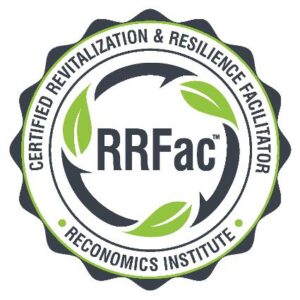 How is it possible that myriad strategies could all have the same goal? Because that shared goal is success. The sole function of a strategy is to achieve success. The proper definition of a strategy is “a technique or method to produce success”.
How is it possible that myriad strategies could all have the same goal? Because that shared goal is success. The sole function of a strategy is to achieve success. The proper definition of a strategy is “a technique or method to produce success”.
I say “proper”, because many writers of dictionaries are in the same state of ignorance, stating that a strategy is a plan. In 2019, when I asked an executive at the American Planning Association how he defined a plan, he said “a plan is a list of crap that no one ever looks at.” That probably differs a bit from the dictionary definition of a plan, but—as with “strategy”—it’s probably far more accurate.
Many “strategy” statements are actually visions, which is something entirely different. A vision is what the strategy is trying to make successful. It’s like confusing a destination with the route that will get you there. A vision without a strategy is just a daydream. And a strategy without a vision is just plain silly: success requires objectives, like verbs require nouns.
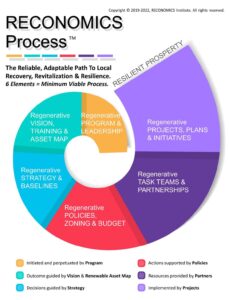 I specified “public leader” above because most military and business leaders know what a strategy is (the effective, successful leaders ones, that is). Good business leaders also know the value of process. They understand that the reliable production of anything requires a process: crops, cars, carpets, or whatever. But a public leader who understands strategy and process is a rare bird indeed.
I specified “public leader” above because most military and business leaders know what a strategy is (the effective, successful leaders ones, that is). Good business leaders also know the value of process. They understand that the reliable production of anything requires a process: crops, cars, carpets, or whatever. But a public leader who understands strategy and process is a rare bird indeed.
For recovery, revitalization and resilience initiatives, the minimum viable process comprises six elements: a regenerative program; a regenerative vision; a regenerative strategy; regenerative policies; regenerative partnerships; and regenerative projects. You can add to it, but you can’t subtract.
The UN folks are far from alone in this failing: the now-defunct 100 Resilient Cities initiative of the Rockefeller Foundation had the same problem that afflicted this UN strategy effort: They were long on content experts, and short on strategic experts.
Their member cities each published a “strategic plan”. I read most of them, which were usually between 50 and 100 pages long. Not one “strategic plan” had an actual strategy.
Every one of them thought the plan itself was the strategy. If the words were synonymous, there would be no need for two of them. This is why some plans are called “strategic plans” and not just plans: they are supposed to be based on a strategy. But a plan’s being based on a strategy is not the same is being that strategy. Just because all life on Earth is carbon-based doesn’t mean that life is carbon.
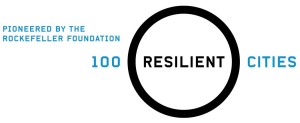 Little wonder then, that the 100 Resilient Cities initiative—which was actually a pretty good idea on the part of former Rockefeller Foundation president Judith Rodin—quickly deteriorated into little more than a plan-writing exercise. This was followed by plan-shelving, which is the fate of almost all urban plans (and the surprising reason for that is explained in RECONOMICS).
Little wonder then, that the 100 Resilient Cities initiative—which was actually a pretty good idea on the part of former Rockefeller Foundation president Judith Rodin—quickly deteriorated into little more than a plan-writing exercise. This was followed by plan-shelving, which is the fate of almost all urban plans (and the surprising reason for that is explained in RECONOMICS).
The chief function of a strategy is to guide decisions on a moment-to-moment basis. Therefore, it has to be concise enough to remember: usually no more than a sentence or two. If you have to pull a document off the shelf to find out what your strategy is, you don’t have one.
I mentioned above that one of the writers of the strategy document for UN Decade on Ecosystem Restoration seems to have accidentally stated a somewhat-concise strategy. Here it is: “The strategy of the UN Decade is to address the six primary barriers described above through a collaborative effort of all the stakeholders along three main pathways. Pathway I will generate the peer-driven, participatory global movement that focuses on upscaling restoration. Pathway II will foster political will so that leaders in the public and private sectors support the global movement and champion restoration. Pathway III will catalyze research and development that generates the technical capacity that is needed to restore ecosystems at scale.”
I say “accidentally” because no attention is drawn to this paragraph anywhere else in this document, which is supposed to be about the strategy. The paragraph is buried on page 5 under the heading “pathways”. It’s not a good strategy, and it could certainly be more concise, but it’s the only attempt to actually state a strategy that appears anywhere in this “strategic” document.
On the other hand, they did a good job with the vision statement: “The overarching vision for the UN Decade is a world where – for the health and wellbeing of all life on Earth and that of future generations – the relationship between humans and nature has been restored, where the area of healthy ecosystems is increasing, and where ecosystem loss, fragmentation and degradation has been ended.”
If they had created a similar-length strategy statement, this 48-page document would have been an excellent “strategic plan.” Unfortunately, no one thought to ask “are we clear on what a strategy is” prior to the launch of all this otherwise-excellent work. As a result, they made the usual amatuer’s mistake of conflating “strategy” and “plan”, and thus have no strategy.
Another area in which the effort fell flat was in their goal statement. Here are their three goals:
- enhancing global, regional, national and local commitments and actions to prevent, halt and reverse the
degradation of ecosystems; - increasing our understanding of the multiple benefits of successful ecosystem restoration;
- applying this knowledge in our education systems and within all public and private sector decision-making.
Any professional manager would take one look at those and say “those are activities, not goals”. A goal, by definition, needs measurement. There are no numbers or dates associated with these activities. Even if we assume the date is 2030 (the end of the Decade on Ecosystem Restoration, the lack of numerically-stated objectives renders these statements relatively meaningless.
One can’t just say “enhance” or “increase”: a proper goal would say “increase by X% by X date”, and the plan would detail how that measurement would be made. How will they know whether they achieved their goals? These are the sorts of “goals” that leaders create when they fear failure. If you can’t measure success, you can’t measure failure.
Here then, are 10 stated actions (tactics) in their “strategy”:
(the following text is taken from this “strategy” page on the UN website)
1. Empower a global movement
The UN Decade’s overarching goal is to stop and reverse the destruction and degradation of billions of hectares of ecosystems. It is a daunting task. It gets even more complicated given the immense diversity of ecosystems and the threats they are facing: from lush forests threatened by land-grabbers and wildfires to agricultural soils so eroded that they may only carry a few more years of harvests. No single entity can steer the course in this endeavor. The UN Decade is therefore designed to connect and empower the actions of the many. Groups and individuals can get informed about restoration opportunities in their area. They can join an initiative already underway or start their own.
2. Finance restoration on the ground
Restoration takes resources. Organizations driving activities on the ground are often underfunded and face long-term financial insecurity. While the benefits of restoration far outweigh the costs, initial investments in the magnitude of billions are needed. Governments, international lenders, development agencies and private business will all have to ramp up their support. Individuals can consider giving a donation, their time or their expertise to a worthy initiative.
3. Set the right incentives
Restoration is good for the planet and people. But leading on restoration is often not rewarded. Not only are there direct up-front investments, but caring for nature can also mean foregoing some of the financial gains of less sustainable practices. However, there are ways to change this: agricultural and fishing subsidies that often finance harmful practices could be used to support restoration instead. In the long-term, healthier ecosystems can produce bigger harvests, more secure incomes and a healthier environment for people.
4. Celebrate leadership
Over the past years, we have witnessed incredible momentum around restoration. Campaigns to plant trillions of trees have captured the imagination of many and communities have come together for mass planting festivals. Under the Bonn Challenge, more than 60 countries have committed to bringing 350 million hectares of forest landscapes back to life. Indigenous peoples have acted as defenders of their ecosystems for generations. The UN Decade will celebrate leadership and encourage others to step up.
5. Shift behaviors
While restoration is always specific to a local environment, the forces that drive the destruction of ecosystems are often connected to global trends. Deforestation, the depletion of fish stocks and the degradation of agricultural soils are all caused by global consumption patterns. The UN Decade will work with all partners to identify and encourage restoration-friendly consumption. This can range from shifting diets to promotion restoration-based products.
6. Invest in research
Restoration is complex. Practices that work in one ecosystem may have adverse impacts in another. As the climate changes, new uncertainties arise. Returning to a former state may not be desirable as hotter temperatures or shifting rainfall call for more resilient plants and crops. Scientific understanding of how to restore and adapt ecosystems is still developing. Considerable investments are needed to identify the best practices to restore our planet – one plot at a time.
7. Build up capacity
Thousands of conservation and restoration initiatives are already underway. The UN Decade will be fuelled by their vision, expertise and dedication. However, these practitioners often face multiple barriers that keep them from taking their projects to scale. Other critical sectors, such as finance, require more data and insights to make informed decisions. As a priority, the UN Decade’s strategy seeks to build the capacity of marginalized groups that stand to lose most from the continued destruction of ecosystems – such as indigenous peoples, women and youth to take an active role in restoration.
8. Celebrate a culture of restoration
The power to revive our environment does not lie with governments, experts and practitioners alone. Far from it: Shifting from plundering the planet to healing it is a cultural challenge. The UN Decade’s strategy therefore calls on artists, storytellers, producers, musicians and connectors to join the #GenerationRestoration.
9. Build up the next generation
It is youth and future generations who are most impacted by the consequences of the current rapid destruction of ecosystems. They also stand to benefit the most from the creation of sustainable jobs based on a restoration economy. The UN Decade’s strategy makes a direct link between the wellbeing of youth and the goals of restoration. Education for restoration will turn today’s children into ecosystem ambassadors, provide skills for sustainable jobs and ensure that the UN Decade’s achievements far outlive its timeframe.
10. Listen and learn
We would like to hear from you. Take a quick survey to help us learn more about you and how you want to be involved. [end of UN text]
If you are in a position to influence the future of the UN Decade on Ecosystem Restoration, please read RECONOMICS: The Path To Resilient Prosperity right away, and pass along what you learn to the powers that be. It’s 400 pages, but it’s written in a very accessible style, so you’ll probably find it far more enjoyable than these dry concepts like “strategy” and “process” might indicate.
Photo of Storm Cunningham by Dave Marcmann.
See the full “strategy” for the UN Decade on Ecosystem Restoration (PDF).

